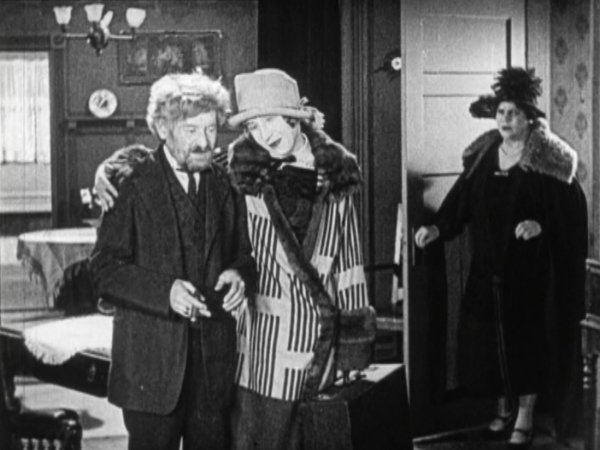DON’T TELL EVERYTHING
Leo McCarey (US 1927)
Max Davidson (1875-1950) had been a familiar face in films for years, with a career stretching back to 1912, when he scored notable successes in two Jackie Coogan films in 1925, The Rag Man and Old Clothes, and soon ended up with his own starring series for Hal Roach. While long specializing in playing stereotypical Jewish tailors and merchants, Max was able to flesh out the character in his Roach series. As Davidson was well into middle age by this time and didn’t move with the balletic grace of Chaplin or do tremendous stunts and falls like Keaton or Lloyd, the focus in all the “world’s against him” situations of this series was on his face and shoulders, for which he developed a repertoire of shrugs, lifted eyebrows, and tilts of the head that conveyed the mounting frustrations of his put-upon papa.
The launch of the Davidson series was overseen by Leo McCarey (1898-1969), who directed the first entries. One of the screen’s great comedy directors, McCarey started in films after early, unsuccessful careers as an amateur boxer, mining investor, and lawyer. His first work was as an assistant to director Tod Browning, which led to Universal giving him the opportunity to direct his own feature. When Society Secrets (1921) failed at the box office, McCarey found himself out of the film business. Luckily he had become friendly with Hal Roach at the Los Angeles Athletic Club, and secured a position writing gags for the “Our Gang” series, but was soon teamed with comedian Charley Chase. Their notable achievements together led to McCarey becoming director-general of the entire studio, where he oversaw all the various elements of the shorts and played a significant role in the development of Stan Laurel and Oliver Hardy as a team.
One of the aspects that McCarey devised for the Davidson comedies was to surround Max with a family of supporting players who would drive him to distraction. A chief irritant in Davidson’s screen life was freckled-faced Spec O’Donnell (1911-1986), who always lived up to his Call of the Cuckoo description, “Love’s Greatest Mistake.” Screen freckles usually denoted a fun-loving character, but Spec’s spots came with an icy heart, a malevolent grin, and beady eyes that loved to see his screen father squirm. Spec had come to films in 1923, and appeared in kids’ comedies at Century, in addition to features such as Mary Pickford’s Little Annie Rooney (1925) and Sparrows (1926). The peak of his career though was at the Hal Roach Studio, where he also bedeviled Charley Chase, James Finlayson, and Marion Byron. When sound arrived he was demoted to bit parts, but never looking very different than he did in the 1920s, still playing newsboys, messengers, office boys, and even a townsperson of rural Mayberry in two episodes of the popular American television series The Andy Griffith Show in the early 1960s.
This is the third entry in the Davidson series, and as in Should Second Husbands Come First? (1927) Lillian Elliott is a rich coquettish widow, but this time both she and Max have obnoxious sons that each keeps hidden from the other. This is a reworking of the basic plot of McCarey’s 1926 Charley Chase comedy Mum’s the Word, but with the important addition of Spec O’Donnell in drag. Male and female drag was an important ingredient in countless silent comedies, but the prize for the most unattractive “he/she” has to go to O’Donnell.
Steve Massa



 Italiano
Italiano